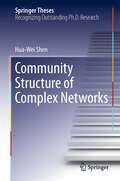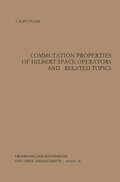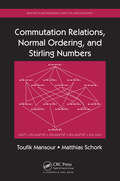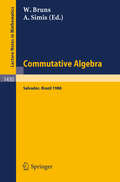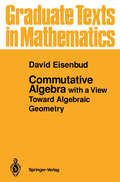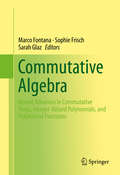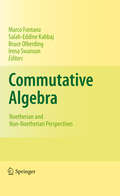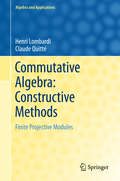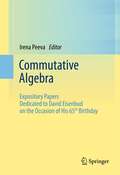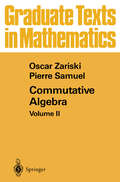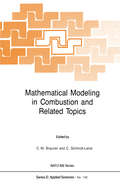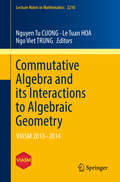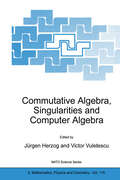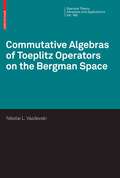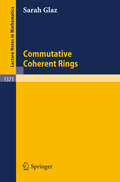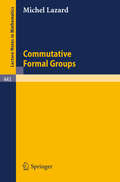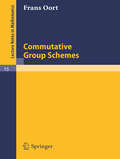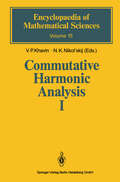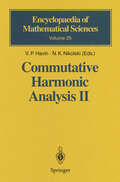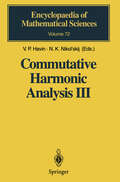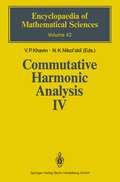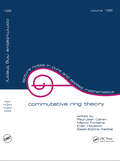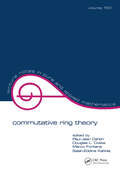- Table View
- List View
Community Structure of Complex Networks (Springer Theses)
by Hua-Wei ShenCommunity structure is a salient structural characteristic of many real-world networks. Communities are generally hierarchical, overlapping, multi-scale and coexist with other types of structural regularities of networks. This poses major challenges for conventional methods of community detection. This book will comprehensively introduce the latest advances in community detection, especially the detection of overlapping and hierarchical community structures, the detection of multi-scale communities in heterogeneous networks, and the exploration of multiple types of structural regularities. These advances have been successfully applied to analyze large-scale online social networks, such as Facebook and Twitter. This book provides readers a convenient way to grasp the cutting edge of community detection in complex networks.The thesis on which this book is based was honored with the “Top 100 Excellent Doctoral Dissertations Award” from the Chinese Academy of Sciences and was nominated as the “Outstanding Doctoral Dissertation” by the Chinese Computer Federation.
Commutation Properties of Hilbert Space Operators and Related Topics (Ergebnisse der Mathematik und ihrer Grenzgebiete. 2. Folge #36)
by Calvin R. PutnamWhat could be regarded as the beginning of a theory of commutators AB - BA of operators A and B on a Hilbert space, considered as a dis cipline in itself, goes back at least to the two papers of Weyl [3] {1928} and von Neumann [2] {1931} on quantum mechanics and the commuta tion relations occurring there. Here A and B were unbounded self-adjoint operators satisfying the relation AB - BA = iI, in some appropriate sense, and the problem was that of establishing the essential uniqueness of the pair A and B. The study of commutators of bounded operators on a Hilbert space has a more recent origin, which can probably be pinpointed as the paper of Wintner [6] {1947}. An investigation of a few related topics in the subject is the main concern of this brief monograph. The ensuing work considers commuting or "almost" commuting quantities A and B, usually bounded or unbounded operators on a Hilbert space, but occasionally regarded as elements of some normed space. An attempt is made to stress the role of the commutator AB - BA, and to investigate its properties, as well as those of its components A and B when the latter are subject to various restrictions. Some applica tions of the results obtained are made to quantum mechanics, perturba tion theory, Laurent and Toeplitz operators, singular integral trans formations, and Jacobi matrices.
Commutation Relations, Normal Ordering, and Stirling Numbers
by Toufik Mansour Matthias SchorkCommutation Relations, Normal Ordering, and Stirling Numbers provides an introduction to the combinatorial aspects of normal ordering in the Weyl algebra and some of its close relatives. The Weyl algebra is the algebra generated by two letters U and V subject to the commutation relation UV - VU = I. It is a classical result that normal ordering pow
Commutative Algebra: Proceedings of a Workshop held in Salvador, Brazil, Aug. 8-17, 1988 (Lecture Notes in Mathematics #1430)
by Winfried Bruns Aron SimisThe central theme of this volume is commutative algebra, with emphasis on special graded algebras, which are increasingly of interest in problems of algebraic geometry, combinatorics and computer algebra. Most of the papers have partly survey character, but are research-oriented, aiming at classification and structural results.
Commutative Algebra: with a View Toward Algebraic Geometry (Graduate Texts in Mathematics #150)
by David EisenbudThis is a comprehensive review of commutative algebra, from localization and primary decomposition through dimension theory, homological methods, free resolutions and duality, emphasizing the origins of the ideas and their connections with other parts of mathematics. The book gives a concise treatment of Grobner basis theory and the constructive methods in commutative algebra and algebraic geometry that flow from it. Many exercises included.
Commutative Algebra: Recent Advances in Commutative Rings, Integer-Valued Polynomials, and Polynomial Functions (De Gruyter Proceedings In Mathematics Ser.)
by Marco Fontana Sophie Frisch Sarah GlazThis volume presents a multi-dimensional collection of articles highlighting recent developments in commutative algebra. It also includes an extensive bibliography and lists a substantial number of open problems that point to future directions of research in the represented subfields. The contributions cover areas in commutative algebra that have flourished in the last few decades and are not yet well represented in book form. Highlighted topics and research methods include Noetherian and non- Noetherian ring theory as well as integer-valued polynomials and functions.Specific topics include:· Homological dimensions of Prüfer-like rings· Quasi complete rings· Total graphs of rings· Properties of prime ideals over various rings· Bases for integer-valued polynomials· Boolean subrings· The portable property of domains· Probabilistic topics in Intn(D)· Closure operations in Zariski-Riemann spaces of valuation domains· Stability of domains· Non-Noetherian grade· Homotopy in integer-valued polynomials· Localizations of global properties of rings· Topics in integral closure· Monoids and submonoids of domainsThe book includes twenty articles written by many of the most prominent researchers in the field. Most contributions are authored by attendees of the conference in commutative algebra held at the Graz University of Technology in December 2012. There is also a small collection of invited articles authored by those who did not attend the conference. Following the model of the Graz conference, the volume contains a number of comprehensive survey articles along with related research articles featuring recent results that have not yet been published elsewhere.
Commutative Algebra: Noetherian and Non-Noetherian Perspectives
by Marco Fontana Salah-Eddine Kabbaj Bruce Olberding Irena SwansonCommutative algebra is a rapidly growing subject that is developing in many different directions. This volume presents several of the most recent results from various areas related to both Noetherian and non-Noetherian commutative algebra. This volume contains a collection of invited survey articles by some of the leading experts in the field. The authors of these chapters have been carefully selected for their important contributions to an area of commutative-algebraic research. Some topics presented in the volume include: generalizations of cyclic modules, zero divisor graphs, class semigroups, forcing algebras, syzygy bundles, tight closure, Gorenstein dimensions, tensor products of algebras over fields, as well as many others. This book is intended for researchers and graduate students interested in studying the many topics related to commutative algebra.
Commutative Algebra: Finite Projective Modules (Algebra and Applications #20)
by Henri Lombardi Claude QuittéTranslated from the popular French edition, this book offers a detailed introduction to various basic concepts, methods, principles, and results of commutative algebra. It takes a constructive viewpoint in commutative algebra and studies algorithmic approaches alongside several abstract classical theories. Indeed, it revisits these traditional topics with a new and simplifying manner, making the subject both accessible and innovative.The algorithmic aspects of such naturally abstract topics as Galois theory, Dedekind rings, Prüfer rings, finitely generated projective modules, dimension theory of commutative rings, and others in the current treatise, are all analysed in the spirit of the great developers of constructive algebra in the nineteenth century. This updated and revised edition contains over 350 well-arranged exercises, together with their helpful hints for solution. A basic knowledge of linear algebra, group theory, elementary number theory as well as the fundamentals of ring and module theory is required. Commutative Algebra: Constructive Methods will be useful for graduate students, and also researchers, instructors and theoretical computer scientists.
Commutative Algebra: Expository Papers Dedicated to David Eisenbud on the Occasion of His 65th Birthday
by Irena PeevaThis contributed volume brings together the highest quality expository papers written by leaders and talented junior mathematicians in the field of Commutative Algebra. Contributions cover a very wide range of topics, including core areas in Commutative Algebra and also relations to Algebraic Geometry, Algebraic Combinatorics, Hyperplane Arrangements, Homological Algebra, and String Theory. The book aims to showcase the area, especially for the benefit of junior mathematicians and researchers who are new to the field; it will aid them in broadening their background and to gain a deeper understanding of the current research in this area. Exciting developments are surveyed and many open problems are discussed with the aspiration to inspire the readers and foster further research.
Commutative Algebra: Volume II (Graduate Texts in Mathematics #29)
by Oscar Zariski Pierre SamuelThis second volume of our treatise on commutative algebra deals largely with three basic topics, which go beyond the more or less classical material of volume I and are on the whole of a more advanced nature and a more recent vintage. These topics are: (a) valuation theory; (b) theory of polynomial and power series rings (including generalizations to graded rings and modules); (c) local algebra. Because most of these topics have either their source or their best motivation in algebraic geom etry, the algebro-geometric connections and applications of the purely algebraic material are constantly stressed and abundantly scattered through out the exposition. Thus, this volume can be used in part as an introduc tion to some basic concepts and the arithmetic foundations of algebraic geometry. The reader who is not immediately concerned with geometric applications may omit the algebro-geometric material in a first reading (see" Instructions to the reader," page vii), but it is only fair to say that many a reader will find it more instructive to find out immediately what is the geometric motivation behind the purely algebraic material of this volume. The first 8 sections of Chapter VI (including § 5bis) deal directly with properties of places, rather than with those of the valuation associated with a place. These, therefore, are properties of valuations in which the value group of the valuation is not involved.
Commutative Algebra: Proceedings of a Microprogram Held June 15–July 2, 1987 (Mathematical Sciences Research Institute Publications #15)
During late June and early July of 1987 a three week program (dubbed "microprogram") in Commutative Algebra was held at the Mathematical Sciences Research Institute at Berkeley. The intent of the microprogram was to survey recent major results and current trends in the theory of commutative rings, especially commutative Noetherian rings. There was enthusiastic international participation. The papers in this volume, some of which are expository, some strictly research, and some a combination, reflect the intent of the program. They give a cross-section of what is happening now in this area. Nearly all of the manuscripts were solicited from the speakers at the conference, and in most instances the manuscript is based on the conference lecture. The editors hope that they will be of interest and of use both to experts and neophytes in the field. The editors would like to express their appreciation to the director of MSRI, Professor Irving Kaplansky, who first suggested the possibility of such a conference and made the task of organization painless. We would also like to thank the IVISRI staff who were unfailingly efficient, pleasant, and helpful during the meeting, and the manager of MSRI, Arlene Baxter, for her help with this volume. Finally we would like to express our appreciation to David Mostardi who did much of the typing and put the electronic pieces together.
Commutative Algebra and its Interactions to Algebraic Geometry: VIASM 2013–2014 (Lecture Notes in Mathematics #2210)
by Nguyen Tu Cuong Le Tuan Hoa Ngo Viet TrungThis book presents four lectures on recent research in commutative algebra and its applications to algebraic geometry. Aimed at researchers and graduate students with an advanced background in algebra, these lectures were given during the Commutative Algebra program held at the Vietnam Institute of Advanced Study in Mathematics in the winter semester 2013 -2014. The first lecture is on Weyl algebras (certain rings of differential operators) and their D-modules, relating non-commutative and commutative algebra to algebraic geometry and analysis in a very appealing way. The second lecture concerns local systems, their homological origin, and applications to the classification of Artinian Gorenstein rings and the computation of their invariants. The third lecture is on the representation type of projective varieties and the classification of arithmetically Cohen -Macaulay bundles and Ulrich bundles. Related topics such as moduli spaces of sheaves, liaison theory, minimal resolutions, and Hilbert schemes of points are also covered. The last lecture addresses a classical problem: how many equations are needed to define an algebraic variety set-theoretically? It systematically covers (and improves) recent results for the case of toric varieties.
Commutative Algebra, Singularities and Computer Algebra: Proceedings of the NATO Advanced Research Workshop on Commutative Algebra, Singularities and Computer Algebra Sinaia, Romania 17–22 September 2002 (NATO Science Series II: Mathematics, Physics and Chemistry #115)
by Jürgen Herzog Victor VuletescuProceedings of the NATO Advanced Research Workshop, held in Sinaia, Romania, 17-22 September 2002
Commutative Algebras of Toeplitz Operators on the Bergman Space (Operator Theory: Advances and Applications #185)
by Nikolai VasilevskiThis unique book is devoted to the detailed study of the recently discovered commutative C*-algebras of Toeplitz operators on the Bergman space over the unit disk. Surprisingly, the key point to understanding their structure and classifying them lies in the hyperbolic geometry of the unit disk. The book develops a number of important problems whose successful solution was made possible and is based on the specific features of the Toeplitz operators from these commutative algebras.
Commutative Coherent Rings (Lecture Notes in Mathematics #1371)
by Sarah GlazThis book provides the first extensive and systematic treatment of the theory of commutative coherent rings. It blends, and provides a link, between the two sometimes disjoint approaches available in the literature, the ring theoretic approach, and the homological algebra approach. The book covers most results in commutative coherent ring theory known to date, as well as a number of results never published before. Starting with elementary results, the book advances to topics such as: uniform coherence, regular rings, rings of small homological dimensions, polynomial and power series rings, group rings and symmetric algebra over coherent rings. The subject of coherence is brought to the frontiers of research, exposing the open problems in the field. Most topics are treated in their fully generality, deriving the results on coherent rings as conclusions of the general theory. Thus, the book develops many of the tools of modern research in commutative algebra with a variety of examples and counterexamples. Although the book is essentially self-contained, basic knowledge of commutative and homological algebra is recommended. It addresses graduate students and researchers.
Commutative Group Schemes (Lecture Notes in Mathematics #15)
by F. OortWe restrict ourselves to two aspects of the field of group schemes, in which the results are fairly complete: commutative algebraic group schemes over an algebraically closed field (of characteristic different from zero), and a duality theory concern ing abelian schemes over a locally noetherian prescheme. The prelim inaries for these considerations are brought together in chapter I. SERRE described properties of the category of commutative quasi-algebraic groups by introducing pro-algebraic groups. In char8teristic zero the situation is clear. In characteristic different from zero information on finite group schemee is needed in order to handle group schemes; this information can be found in work of GABRIEL. In the second chapter these ideas of SERRE and GABRIEL are put together. Also extension groups of elementary group schemes are determined. A suggestion in a paper by MANIN gave crystallization to a fee11ng of symmetry concerning subgroups of abelian varieties. In the third chapter we prove that the dual of an abelian scheme and the linear dual of a finite subgroup scheme are related in a very natural way. Afterwards we became aware that a special case of this theorem was already known by CARTIER and BARSOTTI. Applications of this duality theorem are: the classical duality theorem ("duality hy pothesis", proved by CARTIER and by NISHI); calculation of Ext(~a,A), where A is an abelian variety (result conjectured by SERRE); a proof of the symmetry condition (due to MANIN) concerning the isogeny type of a formal group attached to an abelian variety.
Commutative Harmonic Analysis I: General Survey. Classical Aspects (Encyclopaedia of Mathematical Sciences #15)
by E. M. Dyn'Kin V. P. Khavin S. V. KislyakovThis volume is the first in the series devoted to the commutative harmonic analysis, a fundamental part of the contemporary mathematics. The fundamental nature of this subject, however, has been determined so long ago, that unlike in other volumes of this publication, we have to start with simple notions which have been in constant use in mathematics and physics. Planning the series as a whole, we have assumed that harmonic analysis is based on a small number of axioms, simply and clearly formulated in terms of group theory which illustrate its sources of ideas. However, our subject cannot be completely reduced to those axioms. This part of mathematics is so well developed and has so many different sides to it that no abstract scheme is able to cover its immense concreteness completely. In particular, it relates to an enormous stock of facts accumulated by the classical "trigonometric" harmonic analysis. Moreover, subjected to a general mathematical tendency of integration and diffusion of conventional intersubject borders, harmonic analysis, in its modem form, more and more rests on non-translation invariant constructions. For example, one ofthe most signifi cant achievements of latter decades, which has substantially changed the whole shape of harmonic analysis, is the penetration in this subject of subtle techniques of singular integral operators.
Commutative Harmonic Analysis II: Group Methods in Commutative Harmonic Analysis (Encyclopaedia of Mathematical Sciences #25)
by V. P. GurariiClassical harmonic analysis is an important part of modern physics and mathematics, comparable in its significance with calculus. Created in the 18th and 19th centuries as a distinct mathematical discipline it continued to develop, conquering new unexpected areas and producing impressive applications to a multitude of problems. It is widely understood that the explanation of this miraculous power stems from group theoretic ideas underlying practically everything in harmonic analysis. This book is an unusual combination of the general and abstract group theoretic approach with a wealth of very concrete topics attractive to everybody interested in mathematics. Mathematical literature on harmonic analysis abounds in books of more or less abstract or concrete kind, but the lucky combination as in this volume can hardly be found.
Commutative Harmonic Analysis III: Generalized Functions. Application (Encyclopaedia of Mathematical Sciences #72)
by V. S. Buslaev V. P. Havin B. Jöricke V. P. PalamodovAimed at readers who have learned the principles of harmonic analysis, this book provides a variety of perspectives on this very important classical subject. The authors have written a truly outstanding book which distinguishes itself by its excellent expository style.
Commutative Harmonic Analysis IV: Harmonic Analysis in IRn (Encyclopaedia of Mathematical Sciences #42)
by Sh. A. Alimov R. R. Ashurov E. M. Dyn'Kin S. V. Kislyakov A. K. PulatovWith the groundwork laid in the first volume (EMS 15) of the Commutative Harmonic Analysis subseries of the Encyclopaedia, the present volume takes up four advanced topics in the subject: Littlewood-Paley theory for singular integrals, exceptional sets, multiple Fourier series and multiple Fourier integrals.
Commutative Ring Theory: Proceedings of the Ii International Conference
by Paui-Jean Cahen Marco Fontana Evan Houston Salah-Eddine KabbajPresents the proceedings of the Second International Conference on Commutative Ring Theory in Fes, Morocco. The text details developments in commutative algebra, highlighting the theory of rings and ideals. It explores commutative algebra's connections with and applications to topological algebra and algebraic geometry.
Commutative Ring Theory
by Paul-Jean Cahen Douglas L. Costa Marco Fontana Salah-Eddine Kabbaj" Exploring commutative algebra's connections with and applications to topological algebra and algebraic geometry, Commutative Ring Theory covers the spectra of rings chain conditions, dimension theory, and Jaffard rings fiber products group rings, semigroup rings, and graded rings class groups linear groups integer-valued polynomials rings of finite fractions big Cohen-Macaulay modules and much more!"
Commutative Ring Theory: Proceedings of the Ii International Conference
Presents the proceedings of the Second International Conference on Commutative Ring Theory in Fes, Morocco. The text details developments in commutative algebra, highlighting the theory of rings and ideals. It explores commutative algebra's connections with and applications to topological algebra and algebraic geometry.
Commutative Ring Theory
" Exploring commutative algebra's connections with and applications to topological algebra and algebraic geometry, Commutative Ring Theory covers the spectra of rings chain conditions, dimension theory, and Jaffard rings fiber products group rings, semigroup rings, and graded rings class groups linear groups integer-valued polynomials rings of finite fractions big Cohen-Macaulay modules and much more!"
